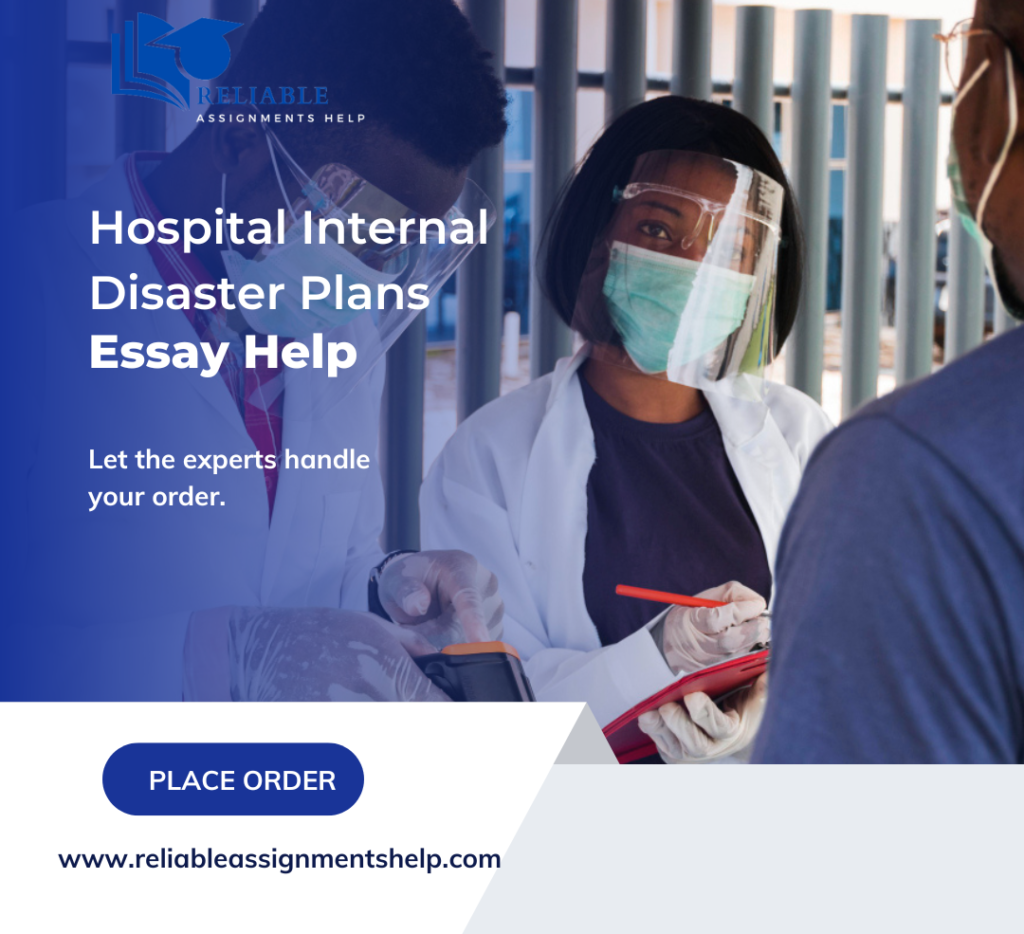Click here (http://www.euro.who.int/__data/assets/pdf_file/0020/148214/e95978.pdf) to read about the standard operating guidelines for hospital disaster plan.
Review the elements required for a disaster plan addressing an internal disaster. Based on your review, create a 2- to 3-page report in a Microsoft Word document covering the hospital’s (internal) disaster plan for how the staff reacts and carries out their duties in the event of an internal disaster.
Your internal disaster plans should include:
- Introduction
- Size and type of your hospital (you decide this)
- Type of internal disaster (fire, explosion, biological etc.)
- Key medical and administrative staff to be contacted
- Central point for communication
- Particular service areas such as intensive care unit (ICU), labor and delivery unit etc.
- Other hospitals in your area and how you intend to coordinate with those facilities (you decide this)
- Implementation on internal transfers (moving patients from one area of the hospital to another)
- Implementation of external transfers
- Evacuation plan
- Conclusion
Cite your sources in your work and provide references for the citations in APA format.
Internal Disaster Plans Essay
Introduction
Hospitals are critical facilities that require comprehensive disaster plans to ensure patient safety and staff preparedness in the event of an emergency. This internal disaster plan outlines the response protocol for [Hospital Name], a [size of hospital] bed facility located in [city, state], in case of an internal disaster such as a fire.
Type of Internal Disaster: Fire
This plan focuses on a fire emergency within the hospital. Fire poses a significant threat to patient and staff safety due to potential smoke inhalation, burns, and building damage. A prompt and coordinated response is crucial to minimize harm and ensure efficient evacuation.
Key Medical and Administrative Staff to be Contacted
- Incident Commander: The Chief Executive Officer (CEO) or designated leader will assume command and oversee the overall response.
- Medical Director: Responsible for coordinating patient care and medical decisions during the emergency.
- Disaster Preparedness Committee: This committee will oversee the implementation of the plan and coordinate with all departments.
- Fire Warden Team: Trained staff responsible for leading evacuation efforts in designated areas.
- Security Personnel: Responsible for securing the facility and maintaining order during evacuation.
Central Point for Communication
The hospital’s Emergency Operations Center (EOC) will serve as the central point for communication during the disaster. Key personnel will gather here to assess the situation, coordinate response efforts, and maintain communication with emergency services.
Particular Service Areas
- Intensive Care Unit (ICU): A dedicated team, including ICU physicians, nurses, and respiratory therapists, will be responsible for the safe evacuation of critically ill patients on ventilators. Portable ventilators will be readily available for transport.
- Labor and Delivery Unit: Obstetricians, nurses, and support staff will prioritize the safe evacuation of pregnant women and newborns. Designated evacuation routes will consider the specific needs of this department.
- Other Departments: Detailed evacuation procedures will be established for all departments, ensuring staff are familiar with designated safe zones and protocols for patient care during evacuation.
Coordination with Other Hospitals
[Hospital Name] maintains strong relationships with other hospitals in the [city/region] through a formal disaster preparedness collaboration. In the event of an internal disaster exceeding our capacity, pre-established communication channels will be used to request patient transfers.
Implementation of Internal Transfers
Internal transfers of patients who are mobile will be conducted through designated exit stairs. Staff will assist less mobile or non-ambulatory patients using evacuation chairs and stretchers. Clearly marked evacuation routes will guide staff and patients to safe zones within the building.
Implementation of External Transfers
If the fire necessitates a complete evacuation of the hospital, patients will be transferred to collaborating hospitals based on pre-arranged agreements and available resources. Ambulances will be requested to transport patients requiring critical care.
Evacuation Plan
A comprehensive evacuation plan will be established, including:
- Fire alarm activation: Upon sounding the alarm, staff will initiate evacuation procedures according to their department protocols.
- Patient care during evacuation: Staff will prioritize patient safety, providing essential care throughout the evacuation process.
- Exit routes and assembly points: Clearly marked escape routes will lead to designated assembly points outside the building.
- Roll call: Once at the assembly point, staff will conduct a headcount to ensure everyone has been evacuated.
Conclusion
This internal disaster plan provides a framework for a coordinated response in the event of a fire within [Hospital Name]. Regular training exercises for staff on their specific roles and evacuation procedures are essential for successful implementation. Additionally, maintaining open communication with collaborating hospitals ensures a smooth transfer process during large-scale emergencies.
Reference
World Health Organization. (2009). Standard operating guidelines for hospital disaster plans. https://iris.who.int/bitstream/handle/10665/184672/9789290232803.pdf?sequence=1

